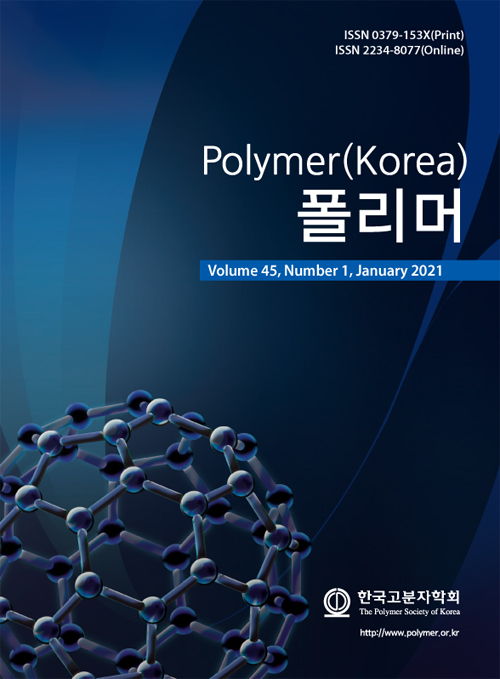Flexible polyurethane foams are used in targeted applications depending on the specific frequency ranges. In this study, low molecular weight polyol (TF400) and DBTDL gelling catalyst are selected as control parameters to examine their effects on the cellular morphology and acoustic properties. As the contents of the TF400 increase, the cavity and pore sizes get smaller. The cell wall area ratio shows the lowest value at 50% TF400, and it increases drastically after 75% TF400 contents. These morphological results are closely related to the highest acoustic activity at 50% TF400. Air flow resistance also gradually increases with increasing the TF400, and it rapidly increases due to high cell wall area ratio after 75%. Therefore, air flow resistance and cellular morphology are dominant factors to improve acoustic properties at low frequency regions in the polyurethane foams including low molecular polyol.
연질 폴리우레탄폼 흡음재는 적용 분야에 따라 요구되는 흡음 성능의 주파수 영역이 결정된다. 본 연구에서는 경질 폼 제조 시에 사용되는 저분자량 폴리올(TF400)과 젤화 촉매인 DBTDL을 기반으로 이들의 함량을 변화시켜 연질 폼을 제조하고 조성에 따라 변화되는 형태학이 흡음 특성에 미치는 영향을 조사하였다. 폴리우레탄폼의 내부 형태학은 TF400 비율이 증가하고 DBTDL이 첨가됨에 따라 공동의 크기는 감소하였고 공동벽 면적비는 저분자량 폴리올 50%에서 최소값을 나타낸 뒤 75% 이상에서 급격하게 증가하였다. 이러한 형태학적 특성에 따라 공동벽 면적비가 최소값인 처방에서 음향 활성과 소음감소율이 가장 높은 결과를 보였다. 유동 흐름 저항은 서서히 증가하다가 공동벽 면적비에 따라 75%에서 급격하게 증가하였다. 따라서 TF400의 혼합에 따라 변화되는 흐름저항과 형태학이 폴리우레탄폼의 저주파 영역 흡음률을 향상시키는 것으로 판단된다.
Keywords: polyurethane foam, cell wall, acoustic activity, air flow resistance, morphology
- Polymer(Korea) 폴리머
- Frequency : Bimonthly(odd)
ISSN 0379-153X(Print)
ISSN 2234-8077(Online)
Abbr. Polym. Korea - 2023 Impact Factor : 0.4
- Indexed in SCIE
 This Article
This Article
-
2021; 45(1): 143-149
Published online Jan 25, 2021
- 10.7317/pk.2021.45.1.143
- Received on Sep 16, 2020
- Revised on Oct 13, 2020
- Accepted on Oct 14, 2020
 Correspondence to
Correspondence to
- Hyeun Kim
-
Department of Chemical Engineering, University of Seoul, 163 Seoulsiripdae-ro, Dongdaemun-gu, Seoul 02504, Korea
- E-mail: jhkimad@uos.ac.kr









 Copyright(c) The Polymer Society of Korea. All right reserved.
Copyright(c) The Polymer Society of Korea. All right reserved.